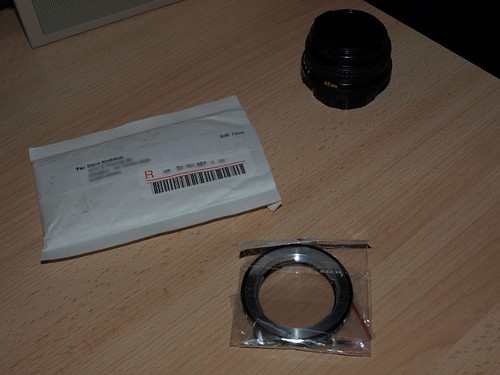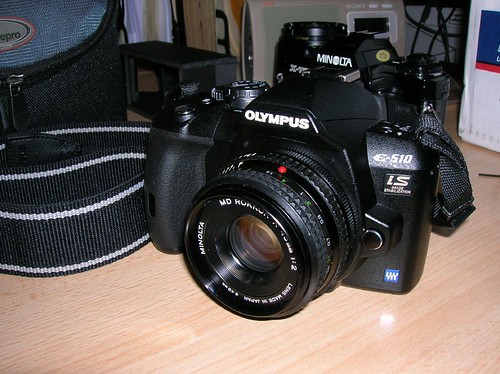During the summer, I bought an Olympus E-510 digital single lens reflex camera. The 510 is a FourThirds camera and because of the of shallow flange of the 4/3 lens mount it is one of the most flexible cameras on the market when it comes to mounting legacy optics (lenses from traditional film SLRs). A 4/3 camera can mount "legacy optics" or lenses from several other manufacturers made before the DSLR era. Although unintended, this makes FourThirds a revolutionary mount. For the first time not only can a photographer mount lenses from different manufacturers who produce lenses to the "open" FourThirds standard, with inexpensive Chinese-made adapters lenses from nearly any manufacturer from the golden age of SLRs can be mounted as well.
Third party adapters can be found for Olympus OM, Nikon, Pentax, Zeiss and Contax. The only one missing from the party was Minolta.
I purchased an inexpensive OM to 4/3 adapter from ebay and mounted several OM lenses, a 50mm f/1.8, 50mm f/1.4, 135mm f/2.8 and the 35mm f/2.8 with success. But I wanted a very light, compact lens. The OM 35mm f/2.8 is very small and light as well as the 50mm f/1.8, but I wanted a "pancake" lens. Like the Hexanon 40mm f/1.8, which can be mounted on 4/3 cameras with some modification. I also wanted a lens in the 40mm range because it gives a similar field of view to a 90mm portrait lens on the 4/3 camera.
I had a Minolta MD Rokkor-X 45mm f/2.0 I used on my Minolta X-700. I hoped to fit it to my E-510 but there was no adapter (other than a very expensive one made a while back). A member of the dpreview forums helped to get a manufacturer in China to make a MD to 4/3 adapter, not as easy task given how thin the mount must be. The manufacturer came through and I bought one of the first adapters they day they went on sale on ebay.

Here is a picture of the lens and adapter a few minutes after the postal person delivered it (We have a wonderful postal delivery person).
This is the MD 45mm f/2.0 mounted to the Olympus E-510 using the adapter purchased from jinfinance on ebay and in the background the donor camera, a mint condition Minolta X-700 purchased from Henry's.

And one of the first test photos I made of a persimmon tree.

I think the lens performs very well.
You can see more examples from the MD 45mm f/2.0 on my flickr album.
Third party adapters can be found for Olympus OM, Nikon, Pentax, Zeiss and Contax. The only one missing from the party was Minolta.
I purchased an inexpensive OM to 4/3 adapter from ebay and mounted several OM lenses, a 50mm f/1.8, 50mm f/1.4, 135mm f/2.8 and the 35mm f/2.8 with success. But I wanted a very light, compact lens. The OM 35mm f/2.8 is very small and light as well as the 50mm f/1.8, but I wanted a "pancake" lens. Like the Hexanon 40mm f/1.8, which can be mounted on 4/3 cameras with some modification. I also wanted a lens in the 40mm range because it gives a similar field of view to a 90mm portrait lens on the 4/3 camera.
I had a Minolta MD Rokkor-X 45mm f/2.0 I used on my Minolta X-700. I hoped to fit it to my E-510 but there was no adapter (other than a very expensive one made a while back). A member of the dpreview forums helped to get a manufacturer in China to make a MD to 4/3 adapter, not as easy task given how thin the mount must be. The manufacturer came through and I bought one of the first adapters they day they went on sale on ebay.

Here is a picture of the lens and adapter a few minutes after the postal person delivered it (We have a wonderful postal delivery person).
This is the MD 45mm f/2.0 mounted to the Olympus E-510 using the adapter purchased from jinfinance on ebay and in the background the donor camera, a mint condition Minolta X-700 purchased from Henry's.

And one of the first test photos I made of a persimmon tree.

I think the lens performs very well.
You can see more examples from the MD 45mm f/2.0 on my flickr album.
Comments